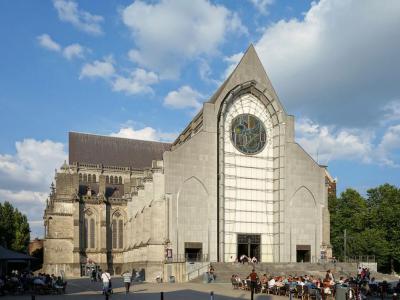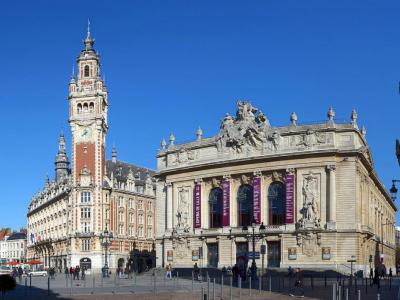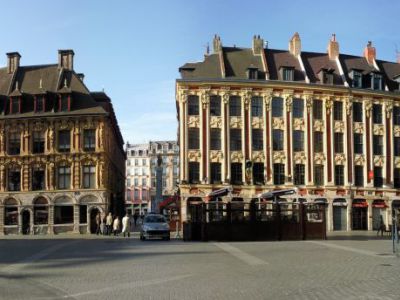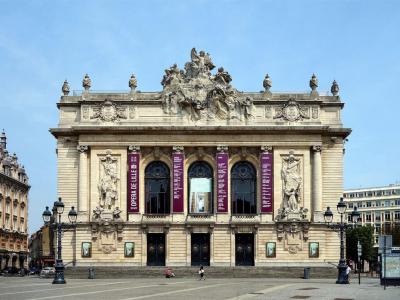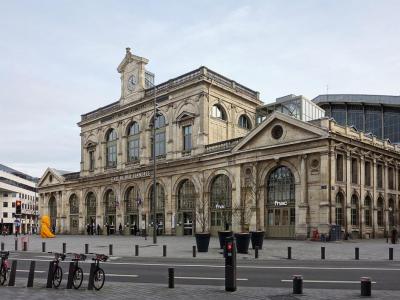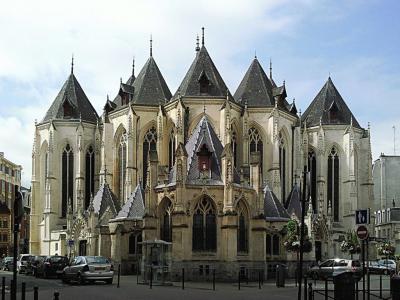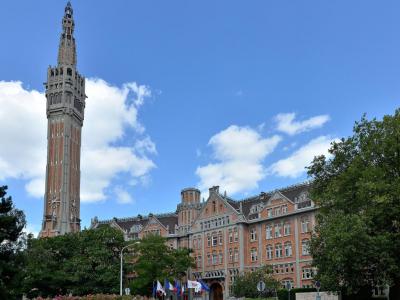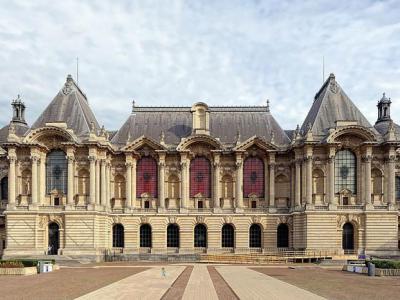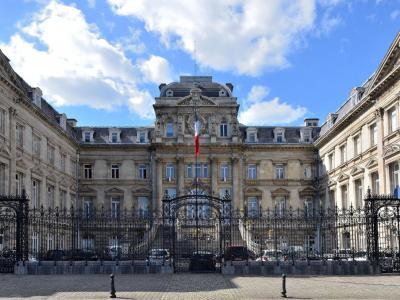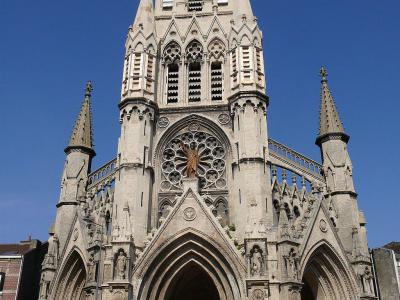
Lille's Historical Buildings Tour (Self Guided), Lille
Historically, Lille's architecture differs from that of other French cities. Prior to being invaded by Louis XIV in 1667, Lille was Flemish, which is evident in its red-brick and other structures, quite uncommon for the rest of France.
Among many things, Lille is reputed for its fabulous historic center, abounding in time-honored buildings, palaces, and churches, offering a great deal of insight into the city's glorious past. Remarkably restored, the Old Town enchants visitors with its delicately gabled roofs and flamboyant, softly dare facades setting off the exuberance and profusion of their decoration.
If you’re on the hunt for culture, there's plenty of it in Lille, set in stone of the numerous, centuries-old and uniquely designed buildings. Here are some of them not to miss:
The Palais des Beaux-Arts (Palace of Fine Arts) – an impressive 19th-century edifice, home to one of the richest museums in France, second only to the Louvre, overlooking the equally grand Préfecture building.
The Chamber of Commerce – the Neo-Flemish-style building constructed between 1910 and 1921.
Le Rang du Beauregard (Beauregard Row) – a stunning example of 17th-century French architecture.
Opéra de Lille – a magnificent Neoclassical theatre built in 1907-1913.
Gare de Lille Flandres – the city’s main railway station, constructed from 1869 to 1892.
Beffroi de l'Hôtel de ville de Lille (Belfry of Lille Town Hall Belfry) – the tallest municipal building in France, with a belfry that has no bells.
Église du Sacré-Cœur de Lille (Sacred Heart Church) – a 19th-century Neo-Gothic Roman Catholic church, one of the largest temples in Lille.
To explore these and other monumental attractions, and to discover the magnificent flavor of Lille’s architecture, take this self-guided walking tour.
Among many things, Lille is reputed for its fabulous historic center, abounding in time-honored buildings, palaces, and churches, offering a great deal of insight into the city's glorious past. Remarkably restored, the Old Town enchants visitors with its delicately gabled roofs and flamboyant, softly dare facades setting off the exuberance and profusion of their decoration.
If you’re on the hunt for culture, there's plenty of it in Lille, set in stone of the numerous, centuries-old and uniquely designed buildings. Here are some of them not to miss:
The Palais des Beaux-Arts (Palace of Fine Arts) – an impressive 19th-century edifice, home to one of the richest museums in France, second only to the Louvre, overlooking the equally grand Préfecture building.
The Chamber of Commerce – the Neo-Flemish-style building constructed between 1910 and 1921.
Le Rang du Beauregard (Beauregard Row) – a stunning example of 17th-century French architecture.
Opéra de Lille – a magnificent Neoclassical theatre built in 1907-1913.
Gare de Lille Flandres – the city’s main railway station, constructed from 1869 to 1892.
Beffroi de l'Hôtel de ville de Lille (Belfry of Lille Town Hall Belfry) – the tallest municipal building in France, with a belfry that has no bells.
Église du Sacré-Cœur de Lille (Sacred Heart Church) – a 19th-century Neo-Gothic Roman Catholic church, one of the largest temples in Lille.
To explore these and other monumental attractions, and to discover the magnificent flavor of Lille’s architecture, take this self-guided walking tour.
How it works: Download the app "GPSmyCity: Walks in 1K+ Cities" from Apple App Store or Google Play Store to your mobile phone or tablet. The app turns your mobile device into a personal tour guide and its built-in GPS navigation functions guide you from one tour stop to next. The app works offline, so no data plan is needed when traveling abroad.
Lille's Historical Buildings Tour Map
Guide Name: Lille's Historical Buildings Tour
Guide Location: France » Lille (See other walking tours in Lille)
Guide Type: Self-guided Walking Tour (Sightseeing)
# of Attractions: 10
Tour Duration: 2 Hour(s)
Travel Distance: 3.7 Km or 2.3 Miles
Author: rose
Sight(s) Featured in This Guide:
Guide Location: France » Lille (See other walking tours in Lille)
Guide Type: Self-guided Walking Tour (Sightseeing)
# of Attractions: 10
Tour Duration: 2 Hour(s)
Travel Distance: 3.7 Km or 2.3 Miles
Author: rose
Sight(s) Featured in This Guide:
- Lille Cathedral
- Chambre de Commerce (Chamber of Commerce)
- Le Rang du Beauregard (Beauregard Row)
- Opéra de Lille (Lille Opera)
- Gare de Lille Flandres (Lille-Flandres Railway Station)
- Église Saint-Maurice de Lille (St. Maurice Church)
- Beffroi de l'Hôtel de ville de Lille (Belfry of Lille Town Hall Belfry)
- Palais des Beaux-Arts (Palace of Fine Arts)
- Préfecture de Lille (Lille Prefecture)
- Église du Sacré-Cœur de Lille (Sacred Heart Church)
1) Lille Cathedral (must see)
The miraculous statue of the Virgin Mary of the Trellis made its home in the Collegiate Church of Saint Peter from the 13th century until 1792. The gilded iron trellis wrapped around the statue was lost in the upheavals of the French Revolution. The statue was recovered and placed in the church of St Catherine, its iron trellis replaced with a wooden one.
In 1853 Charles-Kolb Bernard and his cousin formed a commission to build a fabulous new church in honor of Our Lady of the Treille. Land in the center of Lille was set aside for the construction. The 13th century Gothic styles shown by the cathedrals in Reims, Amiens and Chartres were pressed on the architects and builders.
At first the task was intimidating. It called for a building 433 feet long and spires reaching to 377 feet. The proportions were too large, the budget too small. The cathedral's main facade was not completed until the 1990s. The center is made of an ogive 96 feet high faced with 110 sheets of thick white marble.
A rose window dedicated to the Resurrection is by Ladislas Kijno. The main iron doorway was created by Georges Jeanclos. It is an enormous neo-Gothic building with a bold modern facade designed by architects Pierre-Louis Carlier and Peter Rice. In addition to services, the cathedral hosts concerts and it has a Sacred Art Center in its crypt.
The Cathedral is open all year. Guided tours are available.
In 1853 Charles-Kolb Bernard and his cousin formed a commission to build a fabulous new church in honor of Our Lady of the Treille. Land in the center of Lille was set aside for the construction. The 13th century Gothic styles shown by the cathedrals in Reims, Amiens and Chartres were pressed on the architects and builders.
At first the task was intimidating. It called for a building 433 feet long and spires reaching to 377 feet. The proportions were too large, the budget too small. The cathedral's main facade was not completed until the 1990s. The center is made of an ogive 96 feet high faced with 110 sheets of thick white marble.
A rose window dedicated to the Resurrection is by Ladislas Kijno. The main iron doorway was created by Georges Jeanclos. It is an enormous neo-Gothic building with a bold modern facade designed by architects Pierre-Louis Carlier and Peter Rice. In addition to services, the cathedral hosts concerts and it has a Sacred Art Center in its crypt.
The Cathedral is open all year. Guided tours are available.
2) Chambre de Commerce (Chamber of Commerce)
The Lille Chamber of Commerce building is often referred to as the Nouvelle Bourse (New Stock Exchange), as opposed to the Vieille Bourse (Old Stock Exchange) that is located just opposite, on Place du Théâtre. Constructed between 1910 and 1921, the former was designed by the architect, Louis Marie Cordonnier, with an aim to accommodate the headquarters of the chamber commerce and industry of Greater Lille, established in 1715.
The Neo-Flemish richness of the building is reminiscent of the famous old Dutch town halls. Its splendid 76-meter belfry, equipped with a four-dial clock, is emblematic of the city of Lille (still, it should not be confused with the Art-Deco Belfry of the Town Hall, located a bit further). The fully automated carillon comprises 26 bells, with a total weight of 2000 kg, cast in 1984 by Luigi Bergamo of Cornille-Havard foundry.
The Neo-Regionalist style reflected in plant motifs and scrolls is typical of 17th-century Lille. Inside, there is a 25x25-meter hall of honor with colonnaded galleries, crowned with a majestic 17-meter high dome richly adorned with wonderful frescoes. The building also features a 300-seat auditorium in the basement, known as the Descamps room, Reception rooms, the Sessions room, and the Committee room or the Kuhlmann office, decorated with frescoes and woodwork.
The Chamber of Commerce and Industry was listed as a historic monument in 2015.
The Neo-Flemish richness of the building is reminiscent of the famous old Dutch town halls. Its splendid 76-meter belfry, equipped with a four-dial clock, is emblematic of the city of Lille (still, it should not be confused with the Art-Deco Belfry of the Town Hall, located a bit further). The fully automated carillon comprises 26 bells, with a total weight of 2000 kg, cast in 1984 by Luigi Bergamo of Cornille-Havard foundry.
The Neo-Regionalist style reflected in plant motifs and scrolls is typical of 17th-century Lille. Inside, there is a 25x25-meter hall of honor with colonnaded galleries, crowned with a majestic 17-meter high dome richly adorned with wonderful frescoes. The building also features a 300-seat auditorium in the basement, known as the Descamps room, Reception rooms, the Sessions room, and the Committee room or the Kuhlmann office, decorated with frescoes and woodwork.
The Chamber of Commerce and Industry was listed as a historic monument in 2015.
Sight description based on Wikipedia.
3) Le Rang du Beauregard (Beauregard Row)
Le Rang du Beauregard is a stunning piece of 17th-century French architecture overlooking Place du Théâtre in Lille, listed as a historic monument since 1966.
Built between 1685 and 1687 by the contractor Simon Vollant to the design by the architect Julien Destrée, this row of 14 two-bay houses is a reconstruction of wooden dwellings that had stood here since 1551. Adopted in 1674, the harmonization rules imposed by the Magistrate required uniformity between the new construction and the neighboring buildings, particularly the Vielle Bourse, implying three floors and an attic.
Like the Old Stock Exchange, the ground floor is made up of sandstone arches supporting a three-storey bay of stone and brick surmounted by a mansard. The sobriety of lines of the façade, the colors and patterns of its decoration achieve a synthesis between the French classical architecture, which burst into the city after the capture of Lille by Louis XIV in 1667, and the local Flemish architecture to give birth to a style that could be described as Franco-Lille.
The row owes its current name to a belvedere erected by the Duke of Burgundy, Philippe Le Bon, in 1425, that used to be located just opposite, and was demolished in 1651. Versions concerning the origin of its name – Beauregard – vary; the most common one suggests that perhaps in the 15th century the Italian word “belvedere” had not yet come to designate what is now called "beauregard".
On the right side of the façade, one can see a dozen cannonballs stuck in – reminders of the siege of Lille in 1792, during which the city got showered with more than 30,000 of them. One such cannonball, that hit the Morel brewery, was eventually painted pink with a nipple to represent a breast.
Built between 1685 and 1687 by the contractor Simon Vollant to the design by the architect Julien Destrée, this row of 14 two-bay houses is a reconstruction of wooden dwellings that had stood here since 1551. Adopted in 1674, the harmonization rules imposed by the Magistrate required uniformity between the new construction and the neighboring buildings, particularly the Vielle Bourse, implying three floors and an attic.
Like the Old Stock Exchange, the ground floor is made up of sandstone arches supporting a three-storey bay of stone and brick surmounted by a mansard. The sobriety of lines of the façade, the colors and patterns of its decoration achieve a synthesis between the French classical architecture, which burst into the city after the capture of Lille by Louis XIV in 1667, and the local Flemish architecture to give birth to a style that could be described as Franco-Lille.
The row owes its current name to a belvedere erected by the Duke of Burgundy, Philippe Le Bon, in 1425, that used to be located just opposite, and was demolished in 1651. Versions concerning the origin of its name – Beauregard – vary; the most common one suggests that perhaps in the 15th century the Italian word “belvedere” had not yet come to designate what is now called "beauregard".
On the right side of the façade, one can see a dozen cannonballs stuck in – reminders of the siege of Lille in 1792, during which the city got showered with more than 30,000 of them. One such cannonball, that hit the Morel brewery, was eventually painted pink with a nipple to represent a breast.
Sight description based on Wikipedia.
4) Opéra de Lille (Lille Opera)
Opéra de Lille is a magnificent Neoclassical building, perfectly harmonized with the neighbouring Chamber of Commerce and Old Stock Exchange. The theatre was built from 1907 to 1913.
Following the destruction by fire of the old (1785) opera house in 1903, the architect Louis Marie Cordonnier was appointed, via competition, to build a replacement. Cordonnier's Belle Époque design features an elaborate pediment relief (created by sculptor Hippolyte Lefèbvre), and two flanking bas-relief panels by Alphonse-Amédée Cordonnier and Hector Lemaire. The interior, also very impressive, features the work by yet another prominent sculptor, Edgar-Henri Boutry.
In July 1914, during World War I, the occupying German forces stripped the still unfinished Opéra house of its furniture and equipment to furnish another local venue, the Sebastopol Theatre. After the war, the building was restored and reopened its doors in 1923 for a re-dedication as the Grand Theatre and a "première française".
In 1998, the theatre's physical condition demanded an emergency closure, during mid-season. The ensued renovations evolved into a more ambitious project to set improve the structure's functional capacities. The project was completed in 2004, in time for Lille's year as European Capital of Culture.
Following the destruction by fire of the old (1785) opera house in 1903, the architect Louis Marie Cordonnier was appointed, via competition, to build a replacement. Cordonnier's Belle Époque design features an elaborate pediment relief (created by sculptor Hippolyte Lefèbvre), and two flanking bas-relief panels by Alphonse-Amédée Cordonnier and Hector Lemaire. The interior, also very impressive, features the work by yet another prominent sculptor, Edgar-Henri Boutry.
In July 1914, during World War I, the occupying German forces stripped the still unfinished Opéra house of its furniture and equipment to furnish another local venue, the Sebastopol Theatre. After the war, the building was restored and reopened its doors in 1923 for a re-dedication as the Grand Theatre and a "première française".
In 1998, the theatre's physical condition demanded an emergency closure, during mid-season. The ensued renovations evolved into a more ambitious project to set improve the structure's functional capacities. The project was completed in 2004, in time for Lille's year as European Capital of Culture.
Sight description based on Wikipedia.
5) Gare de Lille Flandres (Lille-Flandres Railway Station)
Gare de Lille Flandres is the main railway station of Lille. The Neoclassical building was designed by the architects Léonce Reynaud and Sidney Dunnett for the Chemins de fer du Nord (Northern Railway Company). The front façade originally came from Paris's Gare du Nord, dismantled and reassembled in Lille.
The initial station on this site, commissioned in 1848, consisted only of a ground floor, which was then added with an extra floor and a pediment with a large clock, commissioned in 1867, to complement the then newly-created Place de la Gare, outside the building.
In 1880, the old roof of the waiting lounge was redone, followed by other improvements, such as the expanded heating system and more. In 1883, further major modifications took place, including the complete redecoration of the waiting hall. In 1887 the Hôtel des Voyageurs was added, and then the rooftop in 1892.
Nowadays, the Lille-Flandres station is the largest TER station in France outside Paris, and is also the second provincial station in terms of attendance, after the Lyon-Part-Dieu station. The term Flanders was added to the name in 1993, when the neighboring Lille-Europe station (located on the LGV Nord) was opened.
The initial station on this site, commissioned in 1848, consisted only of a ground floor, which was then added with an extra floor and a pediment with a large clock, commissioned in 1867, to complement the then newly-created Place de la Gare, outside the building.
In 1880, the old roof of the waiting lounge was redone, followed by other improvements, such as the expanded heating system and more. In 1883, further major modifications took place, including the complete redecoration of the waiting hall. In 1887 the Hôtel des Voyageurs was added, and then the rooftop in 1892.
Nowadays, the Lille-Flandres station is the largest TER station in France outside Paris, and is also the second provincial station in terms of attendance, after the Lyon-Part-Dieu station. The term Flanders was added to the name in 1993, when the neighboring Lille-Europe station (located on the LGV Nord) was opened.
Sight description based on Wikipedia.
6) Église Saint-Maurice de Lille (St. Maurice Church)
The Église Saint-Maurice, on rue de Paris in Lille, is a Gothic- (in part Neo-Gothic-) style hall church that was built over the course of nearly 500 years: from the late 14th century until the late 19th.
The first written mention of a church on this site, the one called Saint-Maurice de Fins, dates back to 1066 and relates to an establishment of the collegiate church of Saint Peter funded with proceeds from the Saint-Maurice. The exact time of its appearance is unknown. Historians associate it with the mallus publicus (a kind of public tribunal) that was held in Lille in 875, although the charter of 1066 suggests a somewhat later timing. No earlier churches in this area are known of.
Some say, however, that it was built on the ruins of a Roman shrine to Mars, hence its dedication to Saint Maurice, rather unique for the diocese of Tournai. Also, the name of Fins comes from the Latin word “fines” which means frontier.
During the French Revolution, the church was looted. Part of its confiscated items were returned in the early 19th century, along with some paintings garnered from the city's other convents. Among them the works by Jakob van Oost dit le Jeune (1639-1713): Transverberation of Saint Thérèse; The Flight to Egypt; The Adoration of the Shepherds; The Marriage of the Virgin; and The Presentation in the Temple. There are also four paintings of the scenes from the Passion by Louis Joseph Watteau (1731-1798).
The church contains the tomb of Charles Ferdinand d'Artois, Duke of Berry, assassinated in 1820, being the youngest son of Charles X, King of France, and his wife Maria Theresa of Savoy.
During the 19th-century restoration led by Philippe Cannissié, the church received a set of Neo-Gothic furniture and was fitted with stained glass windows. It was listed as a historic monument in 1840.
The first written mention of a church on this site, the one called Saint-Maurice de Fins, dates back to 1066 and relates to an establishment of the collegiate church of Saint Peter funded with proceeds from the Saint-Maurice. The exact time of its appearance is unknown. Historians associate it with the mallus publicus (a kind of public tribunal) that was held in Lille in 875, although the charter of 1066 suggests a somewhat later timing. No earlier churches in this area are known of.
Some say, however, that it was built on the ruins of a Roman shrine to Mars, hence its dedication to Saint Maurice, rather unique for the diocese of Tournai. Also, the name of Fins comes from the Latin word “fines” which means frontier.
During the French Revolution, the church was looted. Part of its confiscated items were returned in the early 19th century, along with some paintings garnered from the city's other convents. Among them the works by Jakob van Oost dit le Jeune (1639-1713): Transverberation of Saint Thérèse; The Flight to Egypt; The Adoration of the Shepherds; The Marriage of the Virgin; and The Presentation in the Temple. There are also four paintings of the scenes from the Passion by Louis Joseph Watteau (1731-1798).
The church contains the tomb of Charles Ferdinand d'Artois, Duke of Berry, assassinated in 1820, being the youngest son of Charles X, King of France, and his wife Maria Theresa of Savoy.
During the 19th-century restoration led by Philippe Cannissié, the church received a set of Neo-Gothic furniture and was fitted with stained glass windows. It was listed as a historic monument in 1840.
Sight description based on Wikipedia.
7) Beffroi de l'Hôtel de ville de Lille (Belfry of Lille Town Hall Belfry) (must see)
Has there ever been a belfry without bells? If no bells, why a belfry? That is a question for wiser heads. We know of a belfry with no bells. In Lille, France, the town hall belfry is the tallest municipal building in France and it has no bells.
The belfry tower was inaugurated in 1932. It is part of a reconstruction project to replace the old town hall, destroyed in World War I. It was built by architect Emile Dubuisson. Dubuisson was inspired to resonate his style with the traditional triangular gables of old Flemish houses.
The belfry is built of red bricks and concrete. It is slender and modernistic, attached to the stolid, grandiose town hall. They make a strange but harmonious ensemble. The city had previously three other bell towers. One was demolished in 1601. Another in 1856. The last came down in the Great War.
The current town hall and its tower were erected off-center, in the depressed Saint-Sauver district as a part of an urban renewal project of Socialist Mayor Gustave Delory.
The hall and the belfry show Classic Art-Deco and neo-Flemish elements common to the region. The tower utilizes a sculptured stone style of reinforced concrete. This allows for more strength. The belfry rises to a height of 338 feet. If you love heights, at the top there is a belvedere with nets. It is windy and high, an adventure!
The belfry tower was inaugurated in 1932. It is part of a reconstruction project to replace the old town hall, destroyed in World War I. It was built by architect Emile Dubuisson. Dubuisson was inspired to resonate his style with the traditional triangular gables of old Flemish houses.
The belfry is built of red bricks and concrete. It is slender and modernistic, attached to the stolid, grandiose town hall. They make a strange but harmonious ensemble. The city had previously three other bell towers. One was demolished in 1601. Another in 1856. The last came down in the Great War.
The current town hall and its tower were erected off-center, in the depressed Saint-Sauver district as a part of an urban renewal project of Socialist Mayor Gustave Delory.
The hall and the belfry show Classic Art-Deco and neo-Flemish elements common to the region. The tower utilizes a sculptured stone style of reinforced concrete. This allows for more strength. The belfry rises to a height of 338 feet. If you love heights, at the top there is a belvedere with nets. It is windy and high, an adventure!
8) Palais des Beaux-Arts (Palace of Fine Arts) (must see)
Facing the fountains enclosing the sculpture "Group Of Three" on the Republic Square, is the Palace of Fine Arts. On the other side of the square is the imposing limestone structure, the Prefecture of Lille.
The museum is a grandiose building made in a French end of century style of official architecture. It has elements of the Italian Renaissance with columns, pediments and a French roof. There are two domed pavilions on either side of the monumental façade. The façade is set off with moldings. The wings have loggias and balusters.
The original museum was established by Napoleon in 1801. The Emperor's decree selected 15 French cities to house art seized from churches and occupied lands. The new Museum was opened in 1892 and renovated extensively in 1997. The museum now has 71,500 square feet of exhibition space making it one of the largest museums in France.
The ground floor has military fortification models by Sebastien de Vauban, the famous military engineer of Louis XIV. Sebastien shares this space with 135 French sculptures. On the second floor (French first floor) is a collection of Flemish and Dutch paintings. There are 19th century French paintings from David to Toulouse-Lautrec.
The Museum possesses over 70,000 pieces of Art. The collection includes works by Raphael, Donatello, Van Dyck, Rembrandt, Goya, El Greco, Delacroix, Rubens, Rodin and Chardin, to mention a few.
The museum is a grandiose building made in a French end of century style of official architecture. It has elements of the Italian Renaissance with columns, pediments and a French roof. There are two domed pavilions on either side of the monumental façade. The façade is set off with moldings. The wings have loggias and balusters.
The original museum was established by Napoleon in 1801. The Emperor's decree selected 15 French cities to house art seized from churches and occupied lands. The new Museum was opened in 1892 and renovated extensively in 1997. The museum now has 71,500 square feet of exhibition space making it one of the largest museums in France.
The ground floor has military fortification models by Sebastien de Vauban, the famous military engineer of Louis XIV. Sebastien shares this space with 135 French sculptures. On the second floor (French first floor) is a collection of Flemish and Dutch paintings. There are 19th century French paintings from David to Toulouse-Lautrec.
The Museum possesses over 70,000 pieces of Art. The collection includes works by Raphael, Donatello, Van Dyck, Rembrandt, Goya, El Greco, Delacroix, Rubens, Rodin and Chardin, to mention a few.
9) Préfecture de Lille (Lille Prefecture)
The Préfecture de Lille is an architectural complex that consists of a main building with a ceremonial courtyard and a park, and two more wings. In front of the main edifice, built in hard limestone, there is a beautiful fountain. The architectural style is Classical, with a lot of allegorical figures on the pediments.
Overall, the complex was built throughout the period from 1865 to 1905. The author of the project was the local architect Charles Marteau. The sculptural pediments were made by Félix Huidiez, and the garden at the rear, added after the buildings were completed in 1874, enclosed by a high brick wall with stone chaining, was created by the landscape architect Georges Aumont (the author of many parks in Lille and Roubaix). In 1905, further modifications and adjustments were made by the departmental architect Léonce Hainez.
The actual location, formerly occupied by the city fortifications (demolished in 1865), now overlooking the Palais des Beaux-Arts (built twenty years later), marks the junction of the Old Town of Lille and the new districts annexed in 1858.
The premises, classically arranged in an “H plan”, were conceived as multifunctional, comprising the Prefect's apartment, offices, and halls for receiving distinguished guests. There are also premises for various services, a secretariat, and a hall for celebrations. Adorning the interiors are many works of art: sculptures, paintings, wall paintings, etc.
As of 1975, the Prefecture building has been included in the register of historical monuments.
Overall, the complex was built throughout the period from 1865 to 1905. The author of the project was the local architect Charles Marteau. The sculptural pediments were made by Félix Huidiez, and the garden at the rear, added after the buildings were completed in 1874, enclosed by a high brick wall with stone chaining, was created by the landscape architect Georges Aumont (the author of many parks in Lille and Roubaix). In 1905, further modifications and adjustments were made by the departmental architect Léonce Hainez.
The actual location, formerly occupied by the city fortifications (demolished in 1865), now overlooking the Palais des Beaux-Arts (built twenty years later), marks the junction of the Old Town of Lille and the new districts annexed in 1858.
The premises, classically arranged in an “H plan”, were conceived as multifunctional, comprising the Prefect's apartment, offices, and halls for receiving distinguished guests. There are also premises for various services, a secretariat, and a hall for celebrations. Adorning the interiors are many works of art: sculptures, paintings, wall paintings, etc.
As of 1975, the Prefecture building has been included in the register of historical monuments.
Sight description based on Wikipedia.
10) Église du Sacré-Cœur de Lille (Sacred Heart Church)
The Church of the Sacred Heart is one of the largest temples in Lille, standing 90 meters long, 24 meters wide, and 22 meters high under the main vault. This Roman Catholic church owes its existence to a vow made by the Ladies of the Association des Enfants de Marie du Sacré-Coeur on October 7, 1870 to spare Lille from the Prussian invasion.
The Neo-Gothic church was designed by the architect Jules Batigny, and erected in two phases: between 1875 and 1878, and then between 1895 and 1898, during which the apsidal chapel (Chapelle du Vœu or Chapel of the Vow, behind the choir) with eleven stained glass windows was added. The latter was preceded by a second vow, pronounced by the ladies of the city, concerning the construction of a chapel dedicated to the Sacred Heart and intended to become a specific place of contemplation within the church.
The Sacred Heart temple was ultimately consecrated on June 20, 1902. By that time, its bell tower had not been finished yet. Presently, it houses a carillon of several bells which have been silent for several years now. The steeple, 75 meters high, created by the architect Charles Sarazin, was completed only in 1928. Built of reinforced concrete, it had suffered from bad weather and had to be totally restored between 2005 and 2008.
In April 2018, the church was closed to worship, by a municipal decree, for a period of six months; the reason was dry rot. By now, of all its canopies only seven have been restored; the other five are still in poor condition and await restoration.
The building has been classified as a national historic monument since 1983.
The Neo-Gothic church was designed by the architect Jules Batigny, and erected in two phases: between 1875 and 1878, and then between 1895 and 1898, during which the apsidal chapel (Chapelle du Vœu or Chapel of the Vow, behind the choir) with eleven stained glass windows was added. The latter was preceded by a second vow, pronounced by the ladies of the city, concerning the construction of a chapel dedicated to the Sacred Heart and intended to become a specific place of contemplation within the church.
The Sacred Heart temple was ultimately consecrated on June 20, 1902. By that time, its bell tower had not been finished yet. Presently, it houses a carillon of several bells which have been silent for several years now. The steeple, 75 meters high, created by the architect Charles Sarazin, was completed only in 1928. Built of reinforced concrete, it had suffered from bad weather and had to be totally restored between 2005 and 2008.
In April 2018, the church was closed to worship, by a municipal decree, for a period of six months; the reason was dry rot. By now, of all its canopies only seven have been restored; the other five are still in poor condition and await restoration.
The building has been classified as a national historic monument since 1983.
Sight description based on Wikipedia.
Walking Tours in Lille, France
Create Your Own Walk in Lille
Creating your own self-guided walk in Lille is easy and fun. Choose the city attractions that you want to see and a walk route map will be created just for you. You can even set your hotel as the start point of the walk.
Lille Introduction Walking Tour
Nicknamed in France the "Capital of Flanders", Lille and its surroundings belong to the historical region of Romance Flanders. Legend has it that in 620 AD, Salvaert, Prince of Dijon, passed through the region with his pregnant wife when he was attacked and killed by the local lord Phinaert The Giant. Years later, his son Lyderic avenged his father by killing the Giant and founded the... view more
Tour Duration: 2 Hour(s)
Travel Distance: 4.0 Km or 2.5 Miles
Tour Duration: 2 Hour(s)
Travel Distance: 4.0 Km or 2.5 Miles
The Most Popular Cities
/ view all
